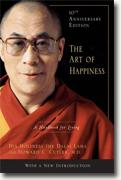The Art of Happiness, 10th Ann. Ed.
The Dalai Lama
book reviews:
· general fiction
· chick lit/romance
· sci-fi/fantasy
· graphic novels
· nonfiction
· audio books
· author interviews
· children's books @
curledupkids.com
· DVD reviews @
curledupdvd.com
newsletter
win books
buy online
links
home
for authors
& publishers
for reviewers

 |
The Art of Happiness, 10th Anniversary Edition: A Handbook for Living The Dalai Lama Riverhead Hardcover 352 pages October 2009 |
|
The Dalai Lama might seem to have little reason to smile. Raised from early childhood to be the chosen spiritual leader of his people and therefore heir to homage and comfort, he was forced to flee like any refugee after the Chinese invaded Tibet and to live the rest of his life (up to now) in exile. He has suffered the loss of homeland, language and culture. Still, he is revered as one of the great spiritual guides of our time, having been given the title His Holiness (and you know who else has that moniker) and occasionally (but not always) greeted and courted by political power players and others of great worldly stature. He is the darling of the political right because he stands in opposition to the communist regime in his homeland, and of the political left because he promotes tolerance and advocates for world peace. He has won the Nobel Peace Prize. He continues to work on behalf of his countrymen. So maybe that is why he smiles - or maybe he smiles because he is simply, actually, happy.
Later, in London, I was deputized by a Quaker journal to go to an appearance of the holy man at a small hall and to write a report. There were so many people present that about half the crowd had to stand, not sit, in an adjoining room, and watch the presentation on a video screen. As soon as the talk was over, The Dalai Lama cruised past his adoring fans and the crush of reporters like myself and went to give his personal greetings to the people in that other room. That, my friends, is compassion in action. Dr. Howard Cutler, who co-produced this book with the Dalai Lama, is a psychiatrist who brings out vivid examples of the holy man’s actions to underpin the words of the famous religious teacher. One story that struck me was an illustration of how happiness spreads in small, simple ways. At a hotel where His Holiness was staying, a maid was standing by the elevator one morning when he and his entourage were heading for breakfast. He smiled at her and asked her “Where are you from?” Taken aback, the woman replied she was from Mexico. The next morning, the same woman and another member of the staff were standing by the elevator when the Dalai Lama passed, and again he spoke to her and to her friend, both of whom were now beaming smiles back. By the end of the conference, Cutler reports, there was a virtual receiving line of hotel staff waiting by the elevator to greet the Dalai Lama, all smiling. By asking one innocuous question in his open, loving way, His Holiness provoked a sense of self-worth and happiness in not just one person but many. By such “parables,” Cutler builds his case that happiness is an art that can be practiced by all of us. As the Dalai Lama has said, “It is very important to generate a good attitude, a good heart, as much as possible. From this, happiness in both the short term and the long term for both yourself and others will come.” He also teaches that “love and compassion are necessities, not luxuries,” and that we should be “compassionate when possible. It is always possible.” Emphasis mine. After reading The Art of Happiness Originally published on Curled Up With A Good Book at www.curledup.com. © Barbara Bamberger Scott, 2009 |
|
|
|
 Click here to learn more about this month's sponsor! |
|
| fiction · sf/f · comic books · nonfiction · audio newsletter · free book contest · buy books online review index · links · · authors & publishers reviewers |
|
| site by ELBO Computing Resources, Inc. | |
 My first view of the Dalai Lama was when he appeared on a presentation of the PBS series
Firing Line, hosted by conservative commentator William F. Buckley back in the 1980s. The Dalai Lama seemed to find Buckley amusing, and he got Buckley laughing at himself by asking him to repeat one of the longwinded questions for which the host was famous. In fact, no matter what the subject, The Dalai Lama flashed his pixie smile at some point in his answer, not an inane giggly smile but a smile of understanding, a smile of grace.
My first view of the Dalai Lama was when he appeared on a presentation of the PBS series
Firing Line, hosted by conservative commentator William F. Buckley back in the 1980s. The Dalai Lama seemed to find Buckley amusing, and he got Buckley laughing at himself by asking him to repeat one of the longwinded questions for which the host was famous. In fact, no matter what the subject, The Dalai Lama flashed his pixie smile at some point in his answer, not an inane giggly smile but a smile of understanding, a smile of grace.